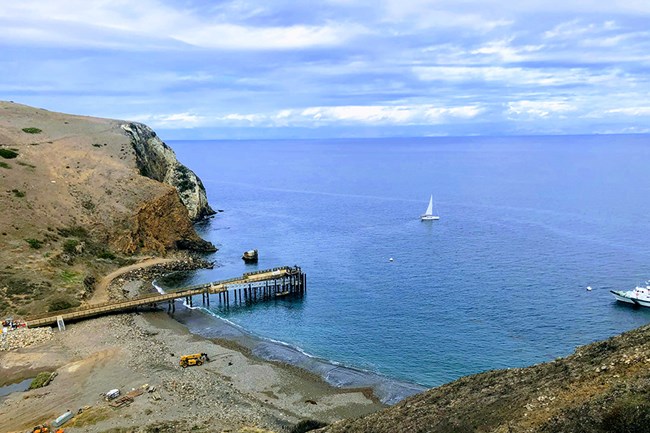
NPS/Ethan McKinley While no person or organization can impact the planet’s climate trajectory alone, together we can influence change, as the solution to climate change is predicated on collective action. Channel Islands is committed to doing our part to respond to climate change in a thoughtful and sustainable way. Because carbon dioxide (and other greenhouse gases driving human-caused climate change) lingers in the atmosphere for thousands of years, it takes a while for the planet to respond to changes in emissions. Even if we stopped emitting all greenhouse gases today, the impact of human-caused climate change would still be felt for generations to come. This means that some level of climate change is “baked in” for the future and requires a two-pronged approach, including both adaptation and mitigation. 
NPS The extensive cloud forest restoration project on Santa Rosa Island was designed with the expectation of increasingly dry future conditions due to human-induced climate change. Restoring these cloud forests and other native plant communities are park priorities that can help ameliorate future climate threats. On East Anacapa island for example, plant restoration is partly motivated by moderating soil temperature, as increased plant cover cools surface soil thereby fostering healthy microorganism growth and increasing nesting area for seabirds16. The park and its tribal partners are also prioritizing inventory and documentation for archeological sites that are vulnerable to climate-related impacts, such as increased erosion and sea level rise. Mitigation refers to actions that reduce the flow of greenhouse gases into the atmosphere. The goal of mitigation is to slow or prevent additional human-caused climate change. Using renewable energy and riding a bike instead of driving a car are both examples of mitigation efforts. The isolated nature of park infrastructure has also led us to be ahead of the curve on utilizing renewable energy to power park operations. Except for our crane systems, 100% of island facilities’ primary power sources are solar, and we source construction materials locally (if possible) in part to reduce emissions from supply chains. 
NPS/Ian Williams The park participates in the Climate Friendly Parks program, which puts climate-friendly behavior at the forefront of our planning and decision making. Our Park Action Plan17 outlines the strategies and actions we’re taking to help mitigate climate change. Some actions we’re taking to reduce greenhouse gas emissions include buying and using energy efficient devices, using renewable energy, and purchasing products made from recycled materials. We also work to educate staff and visitors about climate change and how they can be climate-friendly in their everyday lives. |
Last updated: August 22, 2023
